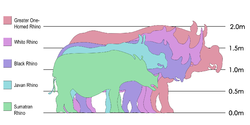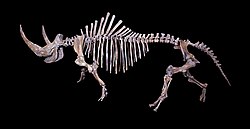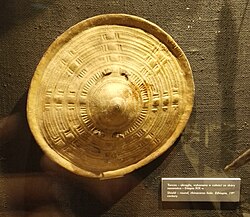Rhinoceros
A rhinoceros (rhino for short) is any animal in the family Rhinocerotidae. They are in the order Perissodactyla, or odd-toed ungulates. There are five living species. Two of these species are native to Africa. Three of these species are also native to Southern parts of Asia.
| Rhinoceros | |
|---|---|

| |
| Rhinoceros species of different genera; from top-left, clockwise: White rhinoceros (Ceratotherium simum), Sumatran rhinoceros (Dicerorhinus sumatrensis), Indian rhinoceros (Rhinoceros unicornis), Black rhinoceros (Diceros bicornis) | |
| Scientific classification | |
| Kingdom: | Animalia |
| Phylum: | Chordata |
| Order: | Perissodactyla |
| Superfamily: | Rhinocerotoidea |
| Family: | Rhinocerotidae Owen, 1845 |
| Type genus | |
| Rhinoceros Linnaeus, 1758
| |
| Extant and subfossil genera | |
|
Ceratotherium | |

| |
| Rhinoceros range | |
Taxonomy
- Family Rhinocerotidae
- Black rhinoceros, Diceros bicornis
- White rhinoceros, or square-lipped rhinoceros Ceratotherium simum
- Javan rhinoceros, Rhinoceros sondaicus
- Indian rhinoceros, Rhinoceros unicornis
- Sumatran rhinoceros, Dicerorhinus sumatrensis
Habitat
All five rhinoceros species are native to Africa or Asia. The two species in Africa are the White rhinoceros and the Black rhinoceros. The three species in Asia (including islands of Indonesia) are the Javan rhinoceros, Sumatran rhinoceros, and Indian rhinoceros.
Life

The rhinoceros is a herbivore. Its favourite food is plants, branches and bushes (if it is a browser species), or grass (if it is a grazer species).
Rhinoceroses have a large horn on the nose. Their horns are not like those of other horned mammals: the rhinoceros' horn is made of keratin packed together very tightly.
The rhinoceroses can weigh up to 2,000 kilograms (4,400 lb) and be up to 375 centimetres (12.30 ft) tall.
Rhinoceros and humans
Only the white rhinoceros is not in critical danger of becoming extinct. They are protected, but hunted mainly by poachers, for their horns. The horns are used in Asian medicine, similar to elephants and tigers, and for dagger handles in Yemen and Oman. Loss of habitat is also a danger to rhinos. Governments have made logging their habitat and poaching illegal.
Rhinoceros Media
Skeleton of Paraceratherium, an extinct rhinocerotoid belonging to Paraceratheriidae, and one the largest land mammals ever
Skeleton of a woolly rhinoceros (Coelodonta antiquitatis) MHNT
An Ethiopian shield from rhinoceros skin, 19th century
Sign in the National Museum of Scotland notifying visitors that the horn on display is a replica; this is because several rhino horns have been stolen from museums.
Western Zhou bronze rhino
Related pages
- Elasmotherium, a large extinct rhinoceros.
Other websites
| Wikispecies has information on: Rhinocerotidae. |
| Wikimedia Commons has media related to Lua error in Module:Commons_link at line 62: attempt to index field 'wikibase' (a nil value).. |








